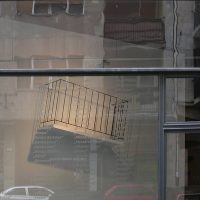The installation of Erika Baglyas stands as a memorial ‘act’; processes running in the space as well as inside of us. After the initial silence, in no time the bunker and its ‘surroundings’ gets intensified. First we discipline ourselves due to the surveillance. We accept the status imposed on us by the Power (camera), we join the game. However, after this recognition, everything gets crowded. The exhibition room gets filled with absence of the words that can not be uttered and deads that can not be committed.
Baglyas is interested in our reaction, in the Other. Despite of its closed world, the installation creates a language of the willingness to know. Curiosity is not functional; questioning here echoes to the way we would ask: how long we keep quiet? How long we keep staring at ourselves in the face of others – the Power and technics. Do we see the reason that the continuity of the past in our present urges for breaking the silence? How long do we wish to remember in the way as the Power does? Are we ready to articulate in the form of actions and speech our defencelessness, our non-remembrance, our positions of observer and observed?
The installation of Baglyas is not only an interpretation of our recent past, the Kádár régime, the activity of Szilveszter Harangozó or the State Security, but also the multitude of spiritual imprints. Departing from our own invisible, still palpable discontents we can reach towards the rupture with the social ritual of the incapacity to remember. In contrast to the simplifications of the politics-driven tansient past processings, Erika Baglyas does not compell for remorse, does not dramatize the comfort situation of the decadelong repression. Alternatively, she establishes the political community of the observers and observed ones. In fact, once we were one in doing and enduring monitoring. Our only chance to continue the present lays in the recognition of these one-man ‘alliances’. Breaking with the camera-memory and silence, with the ambition to iniciate the ‘institutionalization’ of past and present creation through language and dialogue. As our recent past is not self-alienated, but is pieced together from the memory and narrative of the denounced, the denouncer, “the helper and the indifferent outsider, the non-intruding »thirds«” – likewise our present time.
This you should rather see comrade Harangozó.
Balázs Böcskei

